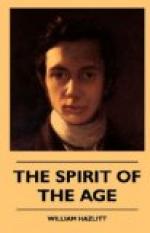his poetical heroines would the reader break a lance
so soon as for Jeanie Deans? What Lady of
the Lake can compare with the beautiful Rebecca?
We believe the late Mr. John Scott went to his death-bed
(though a painful and premature one) with some degree
of satisfaction, inasmuch as he had penned the most
elaborate panegyric on the Scotch Novels that
had as yet appeared!—The Epics are
not poems, so much as metrical romances. There
is a glittering veil of verse thrown over the features
of nature and of old romance. The deep incisions
into character are “skinned and filmed over”—the
details are lost or shaped into flimsy and insipid
decorum; and the truth of feeling and of circumstance
is translated into a tinkling sound, a tinsel common-place.
It must be owned, there is a power in true poetry
that lifts the mind from the ground of reality to
a higher sphere, that penetrates the inert, scattered,
incoherent materials presented to it, and by a force
and inspiration of its own, melts and moulds them
into sublimity and beauty. But Sir Walter (we
contend, under correction) has not this creative impulse,
this plastic power, this capacity of reacting on his
first impressions. He is a learned, a literal,
a matter-of-fact expounder of truth or fable:[B]
he does not soar above and look down upon his subject,
imparting his own lofty views and feelings to his
descriptions of nature—he relies upon it,
is raised by it, is one with it, or he is nothing.
A poet is essentially a maker; that is, he
must atone for what he loses in individuality and
local resemblance by the energies and resources of
his own mind. The writer of whom we speak is
deficient in these last. He has either not the
faculty or not the will to impregnate his subject by
an effort of pure invention. The execution also
is much upon a par with the more ephemeral effusions
of the press. It is light, agreeable, effeminate,
diffuse. Sir Walter’s Muse is a Modern
Antique. The smooth, glossy texture of his
verse contrasts happily with the quaint, uncouth,
rugged materials of which it is composed; and takes
away any appearance of heaviness or harshness from
the body of local traditions and obsolete costume.
We see grim knights and iron armour; but then they
are woven in silk with a careless, delicate hand, and
have the softness of flowers. The poet’s
figures might be compared to old [C] tapestries copied
on the finest velvet:—they are not like
Raphael’s Cartoons, but they are very
like Mr. Westall’s drawings, which accompany,
and are intended to illustrate them. This facility
and grace of execution is the more remarkable, as
a story goes that not long before the appearance of
the Lay of the Last Minstrel Sir Walter (then
Mr.) Scott, having, in the company of a friend, to
cross the Frith of Forth in a ferry-boat, they proposed
to beguile the time by writing a number of verses on
a given subject, and that at the end of an hour’s




